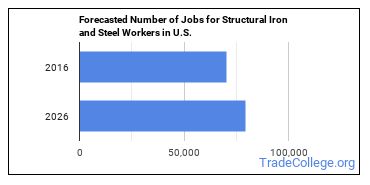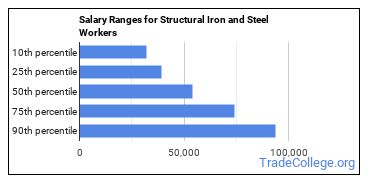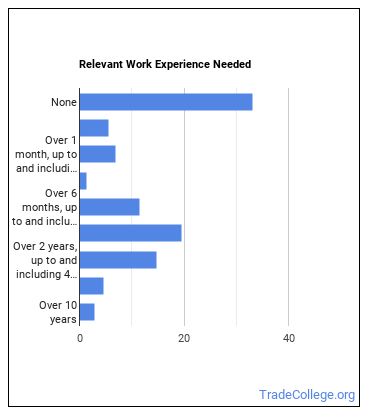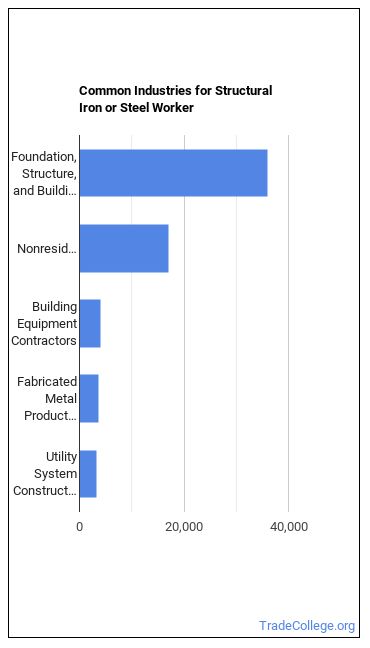What Do Structural Iron or Steel Worker Do?
Structural Iron or Steel Worker Definition Raise, place, and unite iron or steel girders, columns, and other structural members to form completed structures or structural frameworks. May erect metal storage tanks and assemble prefabricated metal buildings.
Structural Iron or Steel Worker Responsibilities
- Read specifications or blueprints to determine the locations, quantities, or sizes of materials required.
- Pull, push, or pry structural steel members into approximate positions for bolting into place.
- Hold rivets while riveters use air hammers to form heads on rivets.
- Bolt aligned structural steel members in position for permanent riveting, bolting, or welding into place.
- Verify vertical and horizontal alignment of structural steel members, using plumb bobs, laser equipment, transits, or levels.
- Assemble hoisting equipment or rigging, such as cables, pulleys, or hooks, to move heavy equipment or materials.
Featured schools near , edit
What Every Structural Iron or Steel Worker Should Know
Below is a list of the skills most Structural Iron and Steel Workers say are important on the job.
Coordination: Adjusting actions in relation to others’ actions.
Operation Monitoring: Watching gauges, dials, or other indicators to make sure a machine is working properly.
Operation and Control: Controlling operations of equipment or systems.
Active Listening: Giving full attention to what other people are saying, taking time to understand the points being made, asking questions as appropriate, and not interrupting at inappropriate times.
Critical Thinking: Using logic and reasoning to identify the strengths and weaknesses of alternative solutions, conclusions or approaches to problems.
Speaking: Talking to others to convey information effectively.
Related Job Titles
- Fitter
- Playground Equipment Erector
- Ornamental Metal Erector
- Bridge Ironworker
- Ornamental Iron Erector
What Kind of Structural Iron or Steel Worker Job Opportunities Are There?
In the United States, there were 70,200 jobs for Structural Iron or Steel Worker in 2016. New jobs are being produced at a rate of 12.8% which is above the national average. The Bureau of Labor Statistics predicts 9,000 new jobs for Structural Iron or Steel Worker by 2026. The BLS estimates 8,700 yearly job openings in this field.

The states with the most job growth for Structural Iron or Steel Worker are Utah, Arizona, and Nevada. Watch out if you plan on working in Maine, Alaska, or Louisiana. These states have the worst job growth for this type of profession.
Structural Iron or Steel Worker Average Salary
The average yearly salary of a Structural Iron or Steel Worker ranges between $32,240 and $93,760.

Structural Iron and Steel Workers who work in New Jersey, New York, or Illinois, make the highest salaries.
Below is a list of the median annual salaries for Structural Iron and Steel Workers in different U.S. states.
| State | Annual Mean Salary |
|---|---|
| Alabama | $48,590 |
| Alaska | $71,080 |
| Arizona | $47,930 |
| Arkansas | $40,760 |
| California | $67,130 |
| Colorado | $52,620 |
| Connecticut | $68,550 |
| Delaware | $50,450 |
| District of Columbia | $58,650 |
| Florida | $43,880 |
| Georgia | $41,760 |
| Hawaii | $74,110 |
| Idaho | $39,230 |
| Illinois | $83,580 |
| Indiana | $56,830 |
| Iowa | $54,850 |
| Kansas | $42,810 |
| Kentucky | $46,640 |
| Louisiana | $50,690 |
| Maine | $50,570 |
| Maryland | $53,200 |
| Massachusetts | $76,810 |
| Michigan | $55,200 |
| Minnesota | $65,800 |
| Mississippi | $41,860 |
| Missouri | $55,770 |
| Montana | $49,600 |
| Nebraska | $40,320 |
| Nevada | $39,840 |
| New Hampshire | $45,880 |
| New Jersey | $86,340 |
| New Mexico | $51,860 |
| New York | $85,410 |
| North Carolina | $41,040 |
| North Dakota | $50,500 |
| Ohio | $59,900 |
| Oklahoma | $42,760 |
| Oregon | $70,540 |
| Pennsylvania | $60,100 |
| Rhode Island | $74,540 |
| South Carolina | $43,640 |
| South Dakota | $42,070 |
| Tennessee | $47,860 |
| Texas | $44,370 |
| Utah | $47,430 |
| Vermont | $47,570 |
| Virginia | $51,220 |
| Washington | $75,020 |
| West Virginia | $54,830 |
| Wisconsin | $58,470 |
| Wyoming | $56,760 |
What Tools do Structural Iron and Steel Workers Use?
Below is a list of the types of tools and technologies that Structural Iron and Steel Workers may use on a daily basis:
- Computer aided design CAD software
- Inventory tracking software
- Turtle Creek Software Goldenseal
- Cost estimating software
- Project scheduling software
How to Become a Structural Iron or Steel Worker
Are there Structural Iron and Steel Workers education requirements?

How many years of work experience do I need?

Where Structural Iron and Steel Workers Work

Below are examples of industries where Structural Iron and Steel Workers work:

Related Careers
Career changers with experience as a Structural Iron or Steel Worker sometimes find work in one of the following fields:
References:
Image Credit: Margo Wright via Public domain
More about our data sources and methodologies.
Featured Schools
 Request Info
Request Info
|
Southern New Hampshire University You have goals. Southern New Hampshire University can help you get there. Whether you need a bachelor's degree to get into a career or want a master's degree to move up in your current career, SNHU has an online program for you. Find your degree from over 200 online programs. Learn More > |
